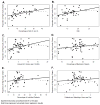Measuring Emergency Department Acuity
- PMID: 28940546
- PMCID: PMC5764775
- DOI: 10.1111/acem.13319
Measuring Emergency Department Acuity
Abstract
Background: Emergency department (ED) acuity is the general level of patient illness, urgency for clinical intervention, and intensity of resource use in an ED environment. The relative strength of commonly used measures of ED acuity is not well understood.
Methods: We performed a retrospective cross-sectional analysis of ED-level data to evaluate the relative strength of association between commonly used proxy measures with a full spectrum measure of ED acuity. Common measures included the percentage of patients with Emergency Severity Index (ESI) scores of 1 or 2, case mix index (CMI), academic status, annual ED volume, inpatient admission rate, percentage of Medicare patients, and patients seen per attending-hour. Our reference standard for acuity is the proportion of high-acuity charts (PHAC) coded and billed according to the Centers for Medicare and Medicaid Service's Ambulatory Payment Classification (APC) system. High-acuity charts included those APC 4 or 5 or critical care. PHAC was represented as a fractional response variable. We examined the strength of associations between common acuity measures and PHAC using Spearman's rank correlation coefficients (rs ) and regression models including a quasi-binomial generalized linear model and linear regression.
Results: In our univariate analysis, the percentage of patients ESI 1 or 2, CMI, academic status, and annual ED volume had statistically significant associations with PHAC. None explained more than 16% of PHAC variation. For regression models including all common acuity measures, academic status was the only variable significantly associated with PHAC.
Conclusion: Emergency Severity Index had the strongest association with PHAC followed by CMI and annual ED volume. Academic status captures variability outside of that explained by ESI, CMI, annual ED volume, percentage of Medicare patients, or patients per attending per hour. All measures combined only explained only 42.6% of PHAC variation.
© 2017 by the Society for Academic Emergency Medicine.
Conflict of interest statement
Figures
References
-
- Harris T, McDonald K. Is the case-mix of patients who self-present to EDs similar to general practice and other acute-care facilities? Emerg Med J. 2014;31(12):970–974. - PubMed
-
- Weissman J, Epstein AM. Case mix and resource utilization by uninsured hospital patients in the Boston metropolitan area. JAMA. 1989 Jun 23;261(24):3572–6. - PubMed
-
- Wiler JL, Welch S, Pines J, Schuur J, Jouriles N, Stone-Griffith S. Emergency department performance measures updates: proceedings of the 2014 Emergency Department Benchmarking Alliance Consensus Summit. Academic Emergency Medicine. 2015 May 1;22(5):542–53. - PubMed
-
- Emergency Department Size Determines the Demographics of Emergency Department Patients. Michalke JA, Patel SG, Siler Fisher A, Hoxhaj S, Augustine J, Davidson SJ, O’Connor RE, Reese CL., IV Annals of Emergency Medicine. 2005 Sep;46(3 Supplement):39.
-
- Patients Per Day and Admission Rate Predict Average Length of Stay in the Emergency Department. Moseley MG, Patel SG, Coletti CM, Augustine J, Davidson SJ, Fisher AS, Hoxhaj S, O’Connor RE, Reese CL., IV EDBA Acad Emerg Med. 2005
Publication types
MeSH terms
Grants and funding
LinkOut - more resources
Full Text Sources
Other Literature Sources




